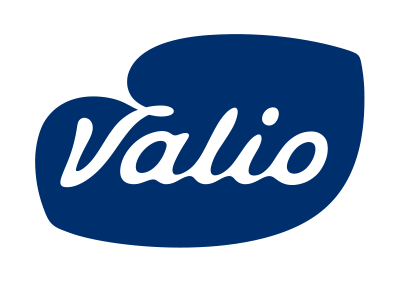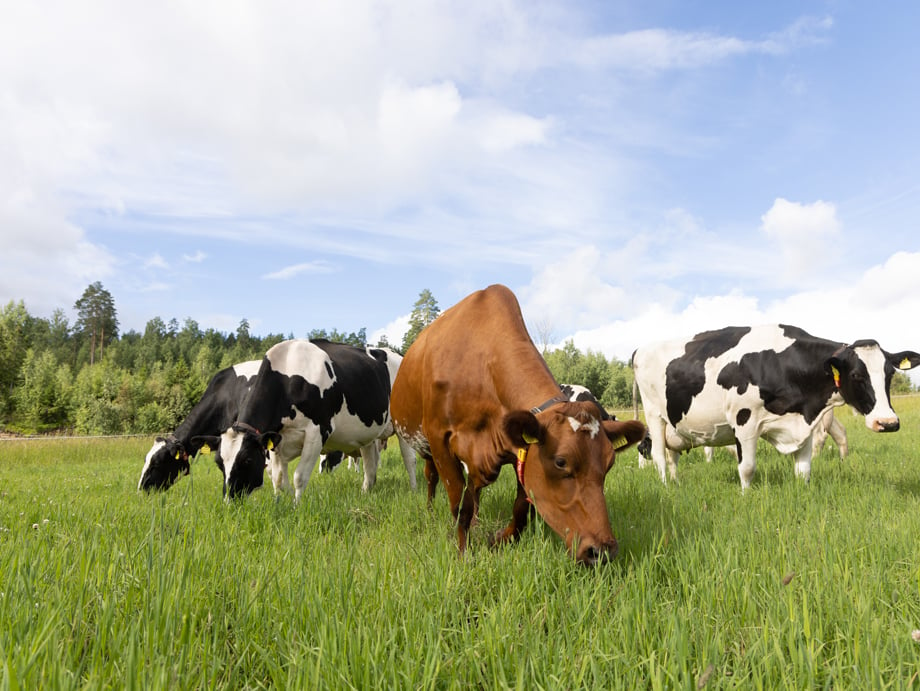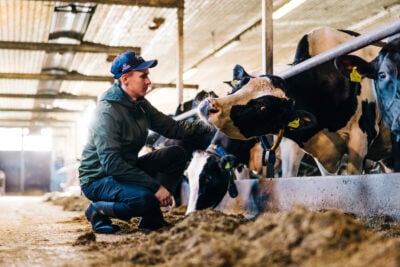Valio’s sustainability bonus programme for dairy farms was updated on 1.5.2023. Previously, farms that have taken actions to improve animal welfare have received additional pay for the milk they supply. Going forward, farms can receive an additional cent per milk litre for farming practices supporting biodiversity, for grazing their cattle and providing access to outdoor activity, and for efforts aiming to reduce the farm’s carbon footprint. With the update, Valio will pay its dairy farmer owners, through cooperatives, nearly 50 million euros annually for sustainability actions.
Previously, the sustainability bonus was two cents per milk litre; now farms can earn an additional cent by combining various actions. For example, the average sized farm of 45 cows currently receives a sustainability bonus of 8,000 euros. With the programme update, it’s possible to increase the bonus to 12,000 euros. About 80% of the milk produced in Finland is within the sphere of Valio’s sustainability bonus programme.
“Since 2021, all Valio farms have been within the sphere of the sustainability bonus programme by committing to the actions required to improve animal welfare. Now it is time to raise the bar to also boost climate actions, biodiversity and the grazing of cows. The new actions included in the sustainability bonus programme are voluntary for the farms, and each farm can choose the programme actions that are the right fit for their farm to reduce the climate impacts of milk production and to increase biodiversity. Animal welfare continues to be an important theme, and now we will focus particularly on increasing the grazing of cows and their year-round access to outdoor activity,” says Ilkka Pohjamo, Senior Vice President, Primary Production at Valio.
Starting 1.5.2023, dairy farms can receive an additional cent per milk litre they produce by, e.g., ensuring grazing and year-round outdoor access, by planting biodiversity zones that benefit pollinators, by practicing carbon farming methods, by cultivating multi-species grasses and by using the Carbo® Farm calculator to report the carbon footprint of the milk they produce.
“More than 2,200 farms are already using the Valio Carbo® carbon footprint calculator and about 1,500 farms, i.e. 25 per cent of all Valio dairy farms, have taken part in carbon farming training. Carbon farming methods are already being used on nearly 85,000 hectares,” says Ilkka Pohjamo.
No food production without biodiversity
Milk production impacts biodiversity in both negative and positive ways. For example, clearing fields in areas of high natural value and cultivating peatlands reduce biodiversity. Grazing cows, on the other hand, enhances biodiversity because cattle manure attracts insects, which in turn attract birds. The positive biodiversity impacts of grasslands for grazing can be enhanced by maximising the rotation period of grasses and by using multi-species grasses. Grazing can be used to control invasive alien species that adversely impact the diversity of native species.
For example, nearly a quarter of all the species classified as threatened in Finland live in highly endangered traditional biotopes. Therefore, the preservation of traditional biotopes through grazing is particularly important. Regenerative farming methods and perennial, multi-species grassland cultivation also enhance biodiversity, improve soil condition and increase carbon sequestration, thus benefiting both the environment and the farmer.
“Valio has developed a multi-species grass seed mixture that improves carbon sequestration and biodiversity, as well as a seed mixture that attracts pollinators and can be used to grow biodiversity strips along the borders of fields, for instance,” says Ilkka Pohjamo.
The heifers on the Pietinmäki farm in Mynämäki have been grazing for 50 years in a traditional biotope area along the coast of Mynälahti bay. The area contains traditional biotopes of various ages, the oldest and most valuable of which is an open seashore meadow. The Pietinmäki farm’s Katja and Henri Hartikainen know that without biodiversity, farming would also cease. By diversifying cultivation and crops, they are more likely to have good yields even in exceptional years.
“It was easy to choose the right actions for our farm from the new voluntary sustainability bonus actions. It’s nice that we’ll be paid for the sustainability actions in the milk price,” they say.
“Last year we planted a landscape field from which people passing by could pick flowers. There were plenty of varieties of winged insects seen in the field. The grass is a mixture of 6-7 species, with peas, broad beans, maize and sorghum,” the Hartikainens note.
Valio is owned by ca. 3,700 Finnish dairy farms through cooperatives, and Valio pays all its operating profit to the owners through the cooperatives.
Dairy farm entrepreneurs can choose from the following actions to collect an additional cent per milk litre:
Animal grazing and access to outdoor activity
- Grazing, outdoor exercise, outdoor access in winter for different groups of animals
Measures to support biodiversity
Biodiversity area
- Cultivation of crops that benefit agrobiodiversity, in particular those suitable for pollinators
Environmental agreements
- The entrepreneur manages a contract area (e.g. traditional biotope, natural pasture, field border of high natural value in terms of biodiversity or landscape importance) in accordance with an environmental contract, or a traditional biotope management contract under the Helmi Habitats Programme.
Reducing the carbon footprint
- Using and updating Valio Carbo® Farm calculator reporting
- Completing carbon farming training
- Using carbon farming practices in the farm’s production of feed




